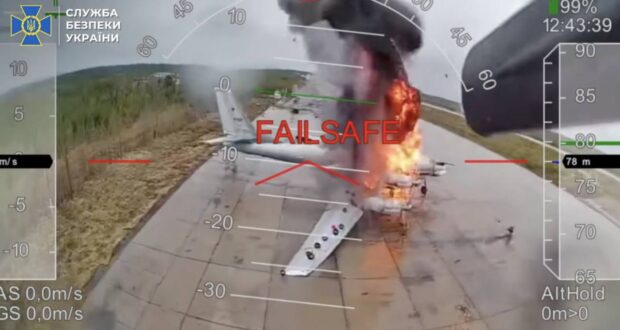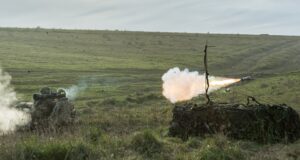By Leo Gardner
21 September, 2025
The biblical tale of David and Goliath has often been used in comparison to the war between Ukraine and Russia. Though an imperfect comparison, as Ukraine is unlikely to defeat Russia outright, there remains a powerful thread in the story that neatly aligns with Ukraine’s struggle.
Goliath, as reported in 1 Samuel 17, was a colossal warrior whose “height was six cubits and a span” and was described as being prepared for battle, carrying a javelin and clad in armour. David, in contrast, faced Goliath armed solely with a slingshot and five smooth pebbles. And yet, by wielding his humble weapons with skill and technique, David toppled the giant.
The story of David and Goliath is not about the use of brute force and triumph through power. Instead, it offers a window into tactical asymmetry and the use of technique and technology to come out on top.
In the case of Ukraine, instead of a sling and pebbles, it has been the use and effective deployment of AI that has played a significant part in sustaining its resistance against Russia.
Despite Moscow’s overwhelming numerical superiority – fielding 1.134 million troops to Ukraine’s 730,000, and possessing over double the number of tanks, aircraft, and heavy weapons – Kyiv’s use of AI has helped restrict human casualties where possible and manage its limited number of personnel.
While AI has also been used by the Ukrainians to fight disinformation and bolster cybersecurity, it is the deployment of AI on the ground and in the battlefield, where the imbalance of troops is most acutely felt, that most strikingly demonstrates the new era of modern warfare.
So well has Kyiv done in harnessing AI, that there is widespread recognition among experts that AI is now a lifeline for Ukraine’s defence and overall security. The International Centre for Defence Studies in Estonia has openly stated that AI-powered solutions are “no longer optional for Ukraine but are crucial for safeguarding Ukrainian lives and national security.”
This article will explore Ukraine’s recent history of AI and, more specifically, how it has deployed AI to play a critical role in the so-called ‘Kill Chain’ for the Ukrainian military.
AI Development in Ukraine
While the war has acted as jet fuel for Kyiv’s development of AI, it is far from a new initiative.
Following the annexation of Crimea, realising that Ukraine required the equipment and nuance to stand up to Russia, volunteer organisations and private enterprises began pioneering AI development, filling gaps left by Ukraine’s underfunded military.
These civilian innovators developed “key technologies such as situational awareness systems and drones for intelligence, surveillance, and reconnaissance”, which led to the development of the Kropyva system and the GIS Arta app, both of which are still used by the Ukrainian military for artillery targeting calculations and battlefield coordination.
Ukraine formalised its approach to AI in 2019, setting up a Ministry of Digital Transformation to promote automation in the public sector. A year later, it established an Expert Committee on the development of AI within the Ministry and then in 2021 released a strategy for integrating AI into its military.
Ukraine continues to use a mix of private AI companies and government projects to integrate AI in its fight against Russia. Through the platform Brave1, it has ensured open communication between the private and public sectors, aiming for a unified and agile approach to AI development in warfare.
AI in the Ukrainian ‘Kill Chain’
Its current use of AI, as mentioned, is particularly prominent in its ‘Kill Chain’, the process by which an army gathers intelligence, processes it and turns it into military action. Ukraine has effectively leveraged the power of AI to streamline and accelerate this process.
At the heart of this is AI-powered intelligence gathering, surveillance and reconnaissance (ISR) which has been the primary use of AI in the war. The first step of gathering intelligence has relied on Unmanned Aerial Vehicles (UAVs), commonly known as drones, as well as the use of imagery from public and private satellites.
These drones, enhanced by cameras equipped with AI, are able to provide powerful data including real-time 3D maps of the terrain, reports on positioning of enemy fortifications, and battlefield changes including the movement of troops. A standout example is the Saker Scout, a domestically produced UAV, which can identify 64 targets, and simultaneously report their coordinates. Many of these drones, though not fully autonomous, also use AI systems to assist with navigation and situational awareness.
The key processing and analysis of the information received from the satellites and drones has also been integrated with AI, helping to free up personnel for core duties, and on the whole speed up the process of intelligence management.
Ukraine has used a mix of its own AI capabilities and other Western technology in this regard. The Griselda system, a Ukrainian startup, processes and analyses vast amounts of information. This data, produced in just 30 seconds, is sent directly to the Ukrainian armed forces via their overarching Delta battle management system, allowing Ukrainian commanders to rapidly implement orders based on accurate information gained at the expense of very few, if any, lives. Palantir Technologies an American software company, has supported Kyiv in integrating different sources of data into an operation map, providing “better situational awareness and control of operations.”
AI also plays a crucial role in the target elimination phase, with drones, yet again, playing a leading role. Target recognition, coupled with AI driven GPS location awareness, has been critical in Ukraine’s offensives against the Russian military. The most famous example was the use of AI in Operation Spider’s web, which saw the destruction of an estimated third of Russia’s bomber fleet including striking 41 strategic bombers and declaring “at least 13” to be destroyed. The drones used were Ukrainian-made ‘Osa’ first-person-view (FPV) drones. While the operation was not fully autonomous, AI played a lead role in supporting both “flight stability and targeting“. Reports say that Ukraine leveraged AI for at least some of the attack by training the system on images of models of Russian aircraft found at museums in Ukraine. Other examples of AI sitting at the forefront of Ukrainian offensive capabilities have also been seen in Swarmer, a Ukrainian start-up focused on developing autonomous drone swarms. It reflects Ukraine’s continued determination to harness the next breakthrough in AI-driven warfare. If Swarmer succeeds in developing drones to coordinate attacks autonomously, it would add yet another lethal dimension to Ukrainian offensive operations, giving them once again critical edge in technological acuity and battlefield innovation.
A Lesson for the West
Taken together, Ukraine’s integration of AI into each stage of the “Kill Chain” reveals a military strategy that serves as a lesson for militaries across the West. From reconnaissance to the final strike, AI has been steadily integrated and skilfully deployed by the Ukrainian resistance, proving itself to be an indispensable asset in modern warfare.
Dubbed by some as the “AI War Lab”, the conflict in Ukraine is considered the first international conflict where both sides have deployed AI for military purposes. The war has displayed to countries around the world just how effective AI can truly be when it is deployed with precision and innovation.
As NATO members begin to commit larger percentages of their GDP to defence spending, lessons emerging from Ukraine should not be overlooked, especially for countries with smaller defence budgets. In Ukraine’s case, AI has acted as a force multiplier, enabling it to better counter the Russian war machine. AI solutions have delivered a crucial advantage, accelerating decision making and action, helping to save time and more importantly, save lives.
In the future, the ability to be technologically nimble will be critical and more crucial than ever. Ukraine has offered itself as the blueprint for the wars of tomorrow. The time for innovation is now. The time for AI is today.
Image: A photo of a FPV-drone-struck military plane Tu-95 at Russia’s Olenya airbase during the attack (Source: Security Service of Ukraine via CC BY 4.0)
 Human Security Centre Human Rights and International Security Research
Human Security Centre Human Rights and International Security Research




